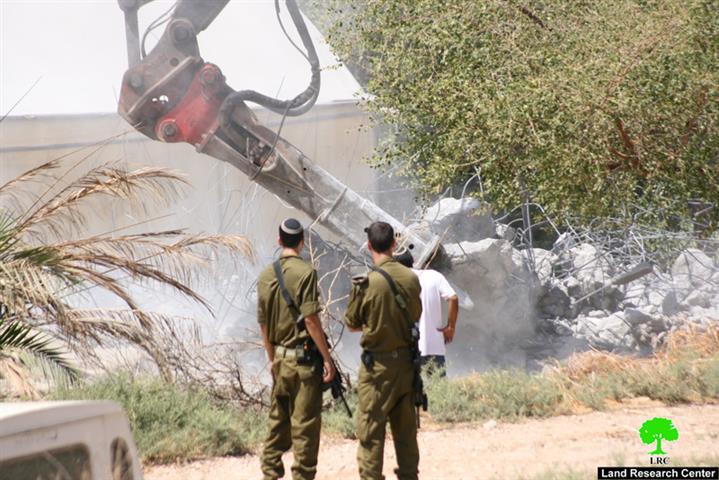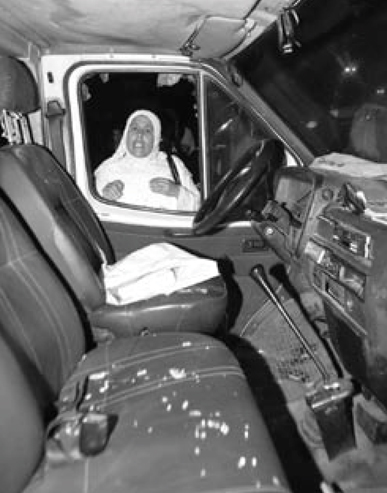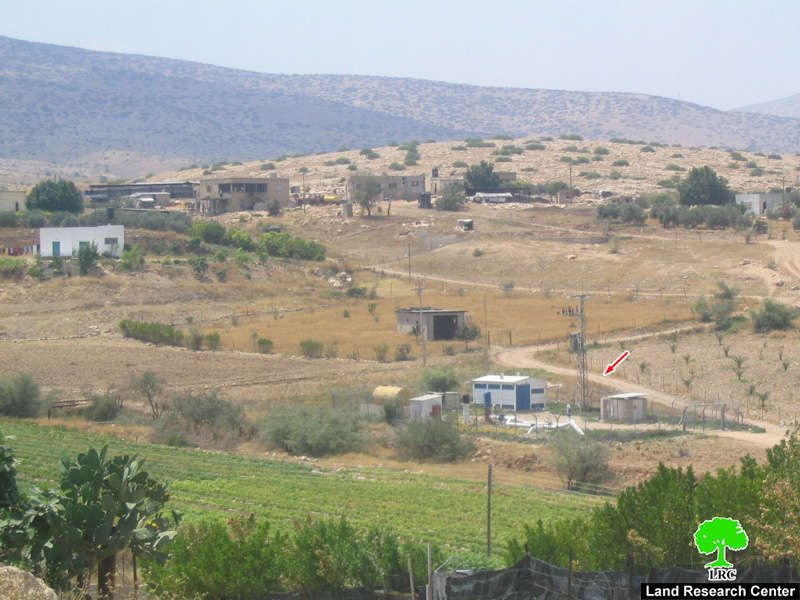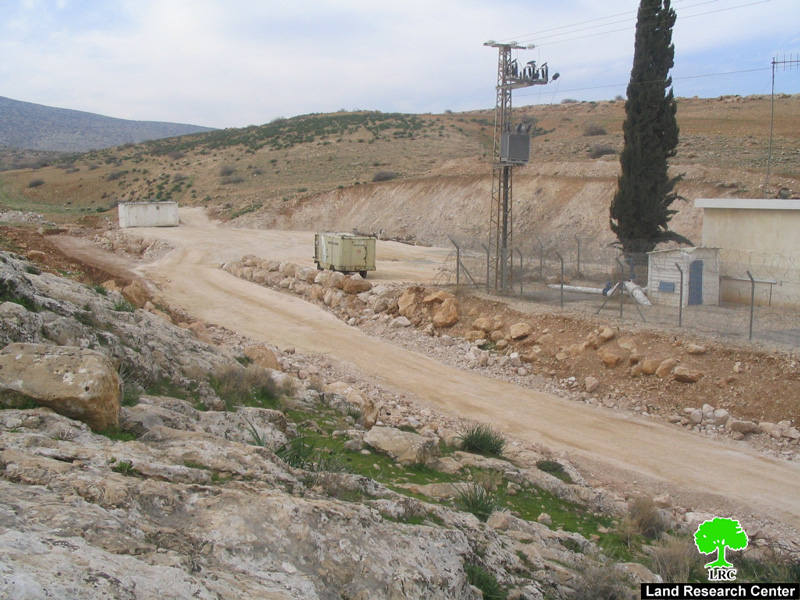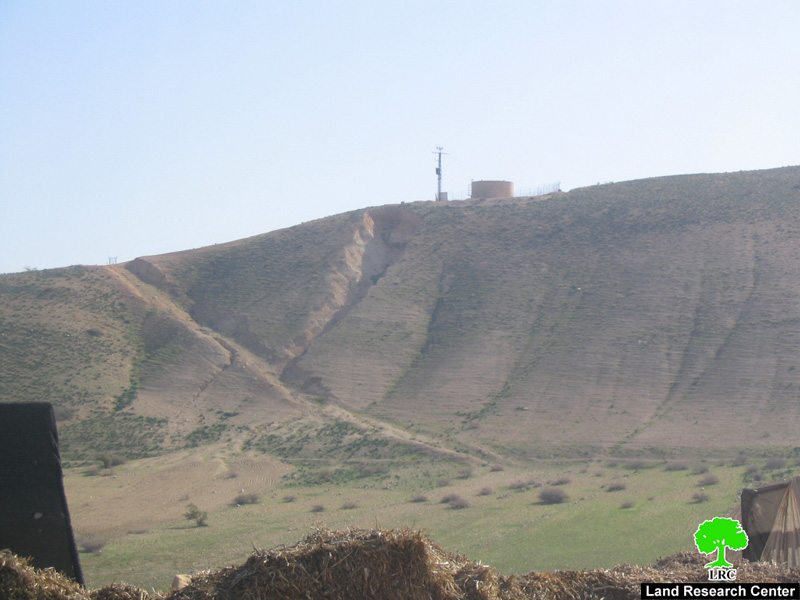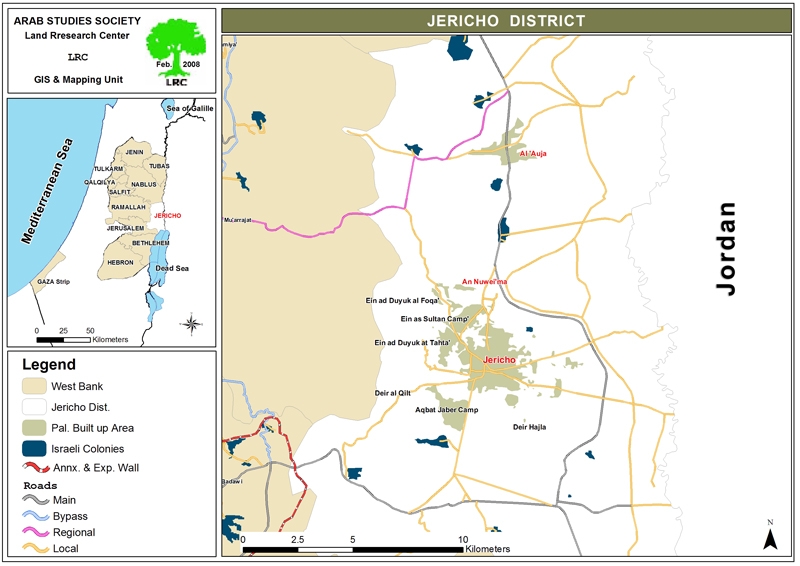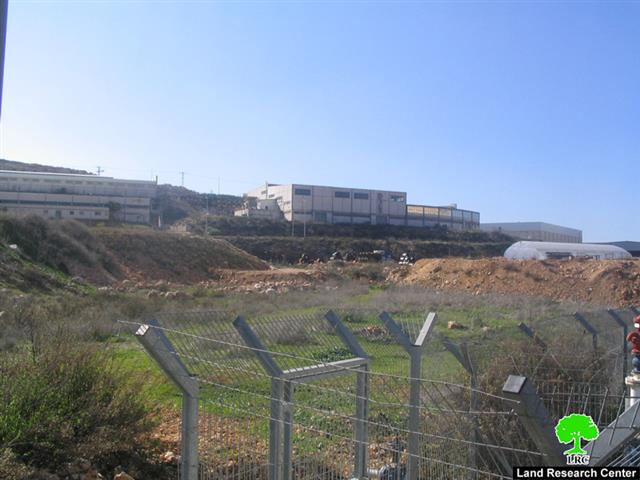Introduction:
The city of Jericho is the oldest city in the world. The Jordan Valley holds a special value as it has the largest land reserve in Palestine constituting 28.5% of the area of the West Bank. Its importance also stems from the fact that it is Palestine’s food basket and its eastern gate. Its geographical location that extends over the length of the Jordan River gives it a strategic importance. The Valley is occupied by the Israeli occupation forces which refuse to negotiate over it with their Palestinian counterparts even within the framework of the Final Status negotiations.
Palestinians living in the Jordan Valley witness on daily basis continuous suffering in the form of the imposition of Israeli military laws on the region in its capacity as a border strip under the complete control of the Israeli military. The suffering is only compounded by the presence of Israeli colonists who continuously try to change geographical and demographical character of the region through spreading, enlarging and connecting the 27 Israeli colonies scattered throughout the Valley. That is in addition to a network of streets, farms and advanced basic infrastructure linking the colonies with each other. On the other hand, Palestinians are not allowed to move from one place to the other in the Valley, to use their land, to establish basic infrastructure, to engage in developmental or agricultural projects or even to have access to roads, health center or public utilities.
Jordan Valley Residents:
The number of Palestinian residents of Jericho and the Jordan Valley is about 43,000 of which 29,000 live in Jericho while the remaining are centered in the villages of Al Ouja, Al Jiftlik, Al Fasayil, Froosh Beit Dajan, Marj Na;eja, Marj Ghazal, Al Zbeidat, Al Noweima and Al Dyouk. Statistics indicate that the Palestinian population of Jordan Valley villages is on the decline due to Israeli pressures, lack of resources and weak steadfastness requirements.
Israeli occupation authorities are doing their utmost to exercise their total control over the Valley via forcing Palestinians out of their villages. In short, Israel is carrying out a policy of quite transfer of Palestinians in the most strategic area of Palestine. A case in point is what took place in the village of Al Fasayil (14 kilometers north west of the city of Jericho) when Israeli forces distributed 6 demolition orders against houses that are considered to be primitive, design wise. Even the only school in the village received a demolition order while the village lacks the very minimum of basic infrastructure which Israeli occupation fiercely refuses to develop. The village of Jifltik (located north of the city of Jericho) is not faring better as Israeli occupation forces demolished 4 houses and a farm in the villages due to “lack of building permit in Area C.” Such demolitions threatens with the occurrence of a housing crisis as it was not the first time that Israeli occupation forces carryout a demolition campaign in the village.
Photo 1: Israeli Bulldozers backed up by Irsaeli Soldiers demolishing a house in
Al Jiftlik village in the Jordan Valley Area .
As for Khirbat Al Hadidiya (located east of the town of Tammoun and close to the settlement of Ro’ei), its Palestinian residents have been removed from it 3 consecutive times during the past 5 years. The Khirbat is one of 15 Bedouin communities not recognized by the occupation in the Valley. The residents, mostly herders, were not spared attacks by Israeli colonists who would attack them daily, damage their tents and confiscate their belonging. The latest such event was the destruction of 7 agricultural and residential establishments in the Khirbet at the beginning of February 2008. Another village that is similarly suffering is the village of Al Aqaba which located to the east of the city of Tubas. According to the new Israeli plans, about 70% of the Master Plan of the village is “illegal.” As such, the number of demolition orders issued against establishments in the villages has reached 21 including those issued against the mosque, sanitary units and the kindergarten in the village. Such pressure has prompted a large number of the residents of the village to flee it to nearby villages and communities looking for a better life.
Israeli occupation authorities have imposed impossible conditions upon those Palestinians who want to call the Jordan Valley home. Such conditions vary between the non-issuance of building permits, the prevention of herding in most of the lands of the Valley, not allowing Palestinians to dig wells or cisterns, the prevention of using agricultural lands under “security” pretexts, the prevention of building schools and health center as well as gas stations in addition to a long list of demolition orders. All of the afore-mentioned tactics fit within the framework of Palestinian transfer and evicting the area for the purpose of colonial expansion.
On the other side of the equation, Israeli occupation authorities have carried out enlargement works in Jordan Valley colonies. The settlement of Makhouls (established in 1968. Area = 233 dunums. Number of colonists in 2005 was about 362) is the prime example of such an enlargement as new housing units were added to it to accommodate an expected influx of Israeli colonist. Also, Israeli colonist from the settlement of Maskiot in the northern parts of the Valley have added more mobile caravans to the settlement also in anticipation of the coming of new colonists.
Photo 2: The Expansion of mechola settlement on lands of 'Ein Al Bayda Lands in the Northern Valleys
Israeli Water Policy in the Jordan Valley:
The northern parts of the Jordan Valley are considered to be the most fertile regions in the West Bank due to the changing weather patterns and the variety of its plant produce. More than 27,000 dunums are planted each year with different kinds of watered vegetables and hundreds of Green Houses established on 400 dunums. That is in addition to thousands of dunums planted with barely and wheat that depends on rainwater. This region is considered to be the vegetable basket of Palestine due to its fertility and the diversity of its agricultural products.
As soon as the West Bank was occupied in the aftermath of the 1967 war, Israeli occupation forces monopolized the right of water excavation and well digging in the Jordan Valley and east of the Governorate of Tubas. This right was later awarded to the Israeli Water Company (Makarot) who, in turn, started the digging process to reach water in deep levels, causing the drying up of Palestinians wells and the increase of its salinity. This condition has forced Palestinians to depend largely on the Israeli company to meet their water needs.
Moreover, Israeli occupation forces have declared the area in the vicinity of the Jordan River as a Closed Military Area the width of which stretches between 1 and 5 kilometers. In accordance with this policy, Israeli occupation authorities have deprived Palestinians from their share of water estimated to be 250 million m3 yearly. The water is usually diverted to the colonies in the Valley and Tubas giving creditability to the statistic that the water share of one Israeli colonist in the Valley is equivalent to the share of 20 Palestinians living in Palestinian communities of the Valley.
Photo 3: a Palestinina well destroyed by the Israeli Occupation forces in
Al Buqei'a village in the Northern Valleys
In addition, Israeli occupation authorities have dug up deep wells inside the colonies beside Palestinian springs especially in the villages of Bardala and Ein Al Baiyda north of the Governorate of Tubas. Moreover, Makarot has dug up two wells (Bardala 1 and Bardala 2) inside the boundaries of the Palestinian village of Bardala. These two wells pump water at the rate of 1500 m3 per hour which led to the drying up of 12 wells and 22 springs used to supply Palestinians with 6 m3 million per year. Another 14 wells in Tubas Governorate are at the verge of drying up due to Israeli over-pumping, The Israeli water pumping policies in the Valley has led also to the destruction of thousands of dunums in the Palestinian villages of Bardala, Kardala, Ein Al Bayda and Al Boqeia, all of which are located in the Governorate of Tubas.
The Village of Bardala and the Israeli Water Polices:
Israeli occupation authorities have dug wells in the village located near and in parallel to the 4 Palestinian wells used by the Palestinians of the village for drinking which led to its dry up. The 4 wells include the well of Mohammad Abdullah, 2 wells belonging to Sa’eed Abu Mansour in addition to the village’s main well. The irony here is that the people of the village are currently dependent on Makarot for drinking water while their village is the main supplier of water for the entire region of the Jordan Valley.
Photo 4: Bardaleh Village outlooking an Israeli Military Base
Photo 5: An Israeli Water Well on Lands of Bardaleh for the purpose
of converting Palestinian Water to Israeli Settlements
It’s been documented that since the beginning of February 2008 Israeli occupation authorities have embarked on digging an additional well beside Al Qweini well, located only 3 kilometers northwest of the village of Bardala in an area called Qaoun. A very fertile land that is famous for its production of vegetables and watermelon is located next the well. It is owned by tens of Palestinian families and extends over an area of 1200 dunums. It is feared that when the digging process is done that a disaster is going to take place in terms of the availability of the water in the village especially that Al Qweini well is the main source of income in the village. That would mean that the residents of the village would be forced to depend on rain-based agriculture which would be a gamble as the quantities of rain water are unpredictable and mostly won’t be enough to meet the agricultural demands. This would, most certainly, increase the unemployment of poverty levels in the village. The situation is the village is already dire as there are currently 70 families that depend on assistance from the World Food Program, 20 other families depend on assistance from the Ministry of Social Affairs while 60 additional families depend on food assistance from the UNRWA.
Photo 6: Construction works at an Israeli Water well in Bardaleh Village
Wadi Al Maleh and the Israeli Water Policies:
Israeli occupation authorities have destroyed the water springs in the area of Wadi Al Maleh and diverted its water content to huge water storage tanks that it established on the nearby mountain ridges. This act has led to the deprivation of the agricuiltural field in the Wadi of water and, thus, made its residentfarmers buy water from the nearby Bardala village and pump it through pipes from Bardala to their lands in Wadi Al Maleh. The pumped water is expensive and its quantity is not enough to cover the agricultural needs of the region.
It is worth mentioning that recently the pumping of water from Bardala to Wadi Al Maleh has stopped which can cause an agricultural disaster in case an alternative source of water was not found in the near future. Israeli occupation authorities are refusing to supply the water which made the farmers depend only on rain-fed agricultural products.
Photo 7: An Israeli Water Wall on the hills of Wadi Al Maleh Area in the Jordan
Valley where Palestinian water is being converted.
The gradually reduced quantities of water have negatively affected the agricultural and herding communities most of which are getting ready to leave the region. This mean an implicit eviction of Wadi Al Maleh leading to a complete control of Israeli occupation authorities on the remaining lands of the Wadi, making it easier to transform it to Closed Military Areas to be used later for colonial expansion.
Israeli occupation authorities have also extended its control over the grazing areas of the Wadi as it prevented Palestinian shepherds and herders from herding in these lands. Not only that, Israeli forces have been using the houses and the farms of the shepherds as military training sites according to B’Tselem report published in January 2008. The report declared this fact depending on testimonies collected from Palestinians in the Wadi as well as from Israeli soldiers. The Israeli Army, in turn, denied that it is carrying training in the Wadi. See Map 1 & Map 2
Prepared by:
The Land Research Center
LRC


